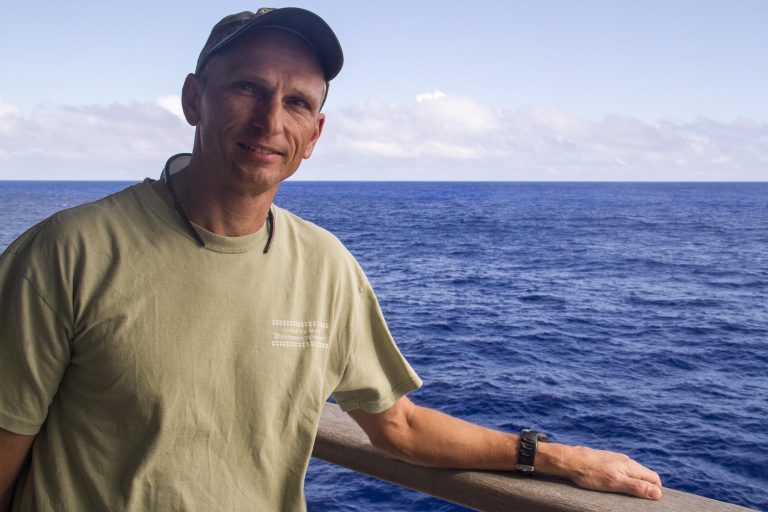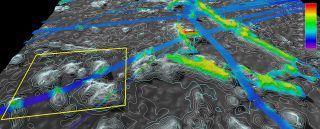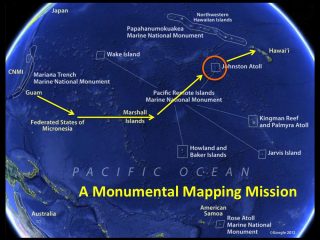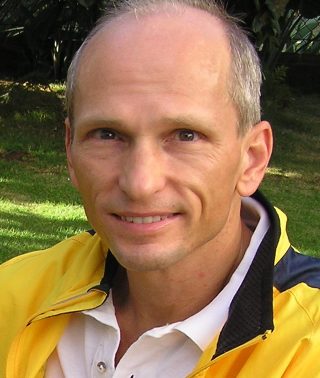Aloha readers! I’m baaack, for another oceanographic expedition on mighty R/V Falkor. I say mighty, because her previous life was as a North Sea fisheries enforcement vessel and so she was initially designed for speed and sturdiness to survive the harsh conditions. At the beginning of our journey we were bashing through the trade seas and currents north of the equator on the way to our study site near Johnston Atoll. It was a bit of a rough ride, although we felt safe and secure in the belly of mighty Falkor, and the conditions steadily improved.

Transruise

This cruise is referred to as a “transruise” by SOI. Its main function is a repositioning of the vessel after conclusion of research work in the Western Pacific to Hawaii and the U.S. West Coast where additional studies and then a shipyard period will occur. In an effort to make the long transit from Guam to Hawai‘i more productive, SOI offered a proposal call for scientists to propose short projects that could be incorporated into the repositioning plan. My project was chosen, partially because it was right on the cruise track to Hawaii, and it was also a fairly simple project that uses Falkor’s built-in sonar and magnetometer systems. Thus, little mobilization and no modification of existing systems were required.
As for the “I’m baaack” part, my science team and I were aboard Falkor in 2014 for two long cruises mapping the Papahānaumokuākea Marine National Monument in the Northwestern Hawaiian Islands. This time the team is scaled down from nine people to only three, because we will only have four to six days on site between the transit to and from. Fortunately, Schmidt Ocean Institute took advantage of the many available berths ( bunks) and assembled a diverse group of education and outreach folks to accompany us on our voyage. In fact, they outnumber our traditional science team two to one, an extremely odd occurrence! Fortunately, again, they have agreed to help us out with survey watch stands once we arrive in the study area.
A Busy Home Away From Home

I sail quite often on the two University of Hawai‘i (UH) research vessels, so I know them and their regular crew members quite well. Coming aboard Falkor in Guam last week, I had the same feeling. There is little turnover here, and it was nice to see many familiar smiling faces along with meeting some new ones. The crew is competent, friendly, and accommodating, which has made this nearly three-week cruise much more pleasant. One of the challenges, which may sound odd, is the number of transit days we’ve had to endure (~14), compared to the few we will actually be surveying on site (~4). Much of the work I do is around the Hawaiian Islands, and leaving from Honolulu has us working within hours to maybe 24 hours (at most) from departure. On this cruise, having ten days to prepare and occupy us is both a luxury and a curse. Given that we departed during the holidays, we were a bit further behind in preparations than usual, so the extra time aboard on the “front end” was welcome. Also, more time getting to know the education/outreach team members, who we had never met, was a bonus. Beyond that, I brought a copy of my hard drive back at the UH so I have plenty of other things to work on….or ignore!
As for how the cruise is going – so far, so good. This is our fourteenth day at sea and we still have a few days to go. We acquired multibeam data on the transit and began editing (processing) it, as well as training other people during that time. Much of the cruise track went across flat abyssal seafloor, so there were not too many features of interest at the beginning after we crossed over the Mariana Trench and entered the Pacific Basin. However, once we began passing through the Marshall Islands we entered a region of seamounts, small islands, and atolls, so the incoming data became more interesting to look at and work with.
Other aspects that kept us busy included giving presentations to the extended science team and/or or ship crew. The ship’s crew likes to have a Seminar at Sea every few days, usually from the onboard science team on a variety of topics. For example, Jonathan Tree, a recent Master of Science graduate, spoke about rocks from the seafloor and the method/history of geologic mapping. Between educating the educators, the crew, and the students and public ashore, we have turned what was to be simply a repositioning of the ship from point-to-point into what we hope is a rich and productive research and educational experience for all who choose to join the journey. I will talk more about what is especially interesting to me about this project in a future post, but for now, I’ll just say we are #Mappin’ the ‘Floor where no one has mapped before!

